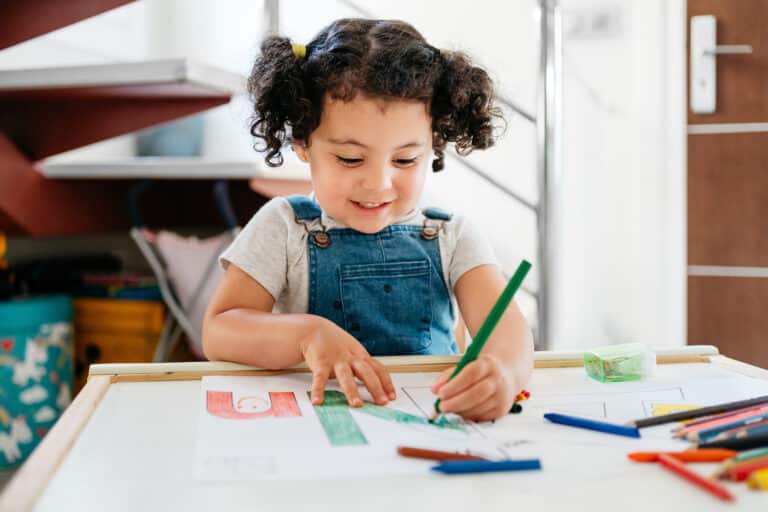It’s science: Having a routine helps your family be happier

We’re all in.
We independently select and share the products we love—and may receive a commission if you choose to buy.
Table of Contents
In the chaos of modern life, days with young children can easily drift into a haphazard, wild survival mode. Dinners, activities and bedtime routines start to resemble a fly-by-the-seat-of-your pants style rather than an intentional one.
However, science shows that routines and rituals can be one of the most important contributors to a joyful and connected family. Routines for kids can increase happiness for everyone.

Research suggests that family routines are related to parenting competence, child adjustment and marital satisfaction. Studies have found that routines can also promote children’s language acquisition, academic skills, social skills and emotional bonds with their parents. Here are four ways routines for kids reduce power struggles, calm stressful circumstances and promote humor, stability and closeness among families.
Related: This is the biggest indicator of a child’s happiness, survey says
4 ways routines for kids make families happier
1. Routines invite cooperation
Laura Markham of Aha Parenting notes that having set routines helps prevent kids from feeling “pushed or bossed around” because they know the activity “is just what we do at this time of day.” Knowing what to expect helps them develop a sense of mastery and helps them be less oppositional, more cooperative and more independent.
One way to develop routines is with when/then wording. For example, “When you have your pajamas on, then we can read a book.”
To drastically reduce daily power struggles, set up expectations such as:
- “All homework must be done before an electronic device is turned on.”
- “You must be dressed for school before you have breakfast.”
- “Your room needs to be clean before you go out on Friday night.”
The alternative—arbitrary amounts of T.V. time, random bedtimes, inconsistent responsibilities, haphazard dinners, or a jumbled order of activities—Markham argues, invites conflicts.
Related: Why I got strict about a 7 p.m. bedtime for my kids
2. Routines offer safety, comfort and ease to the day
Knowing what to expect and when to expect it helps kids feel safe and move through their days with greater ease.
For example, research suggests that children with regular bedtime routines tend to sleep better and longer. Elizabeth Pantley, author of “The No-Cry Sleep Solution,” details how being absolutely consistent about a baby’s bedtime routine—such as bath, book, turning the same light on, singing the same lullaby, playing same white noise and giving the same pacifier and lovey—in the same order every day “cues” a baby that it’s bedtime, provides comfort and helps them fall asleep easier. Having a set routine for after-school or weekends also helps kids relax and cooperate.
Related: Signs of anxiety in kids: What’s typical, what’s not
3. Routines act as a “stability anchor” and relieve stress
The comfort and predictability stemming from routines acts as a “stability anchor.” It helps both parents and children relieve stress, reinforces emotional calm, and decreases anxiety.
Routines also help comfort children in unfamiliar or tough circumstances. For example, if your child loves listening to you read a bedtime story before lights go out, doing so may help her sleep when she’s in a different environment.
In an early childhood setting, a routine can be developed between a parent and child or a teacher and child to ease separations. In a doctor’s office or hospital, rituals can ease stress over blood draws, shots, or difficult procedures.
According to Steinglass and colleagues, family stress is often first noted by the disruption of family routines. However, if routines are maintained under potentially vulnerable conditions such as divorce or financial strain, families are able to adapt better to change. Routines can also help family members stay connected despite interpersonal conflicts.
Related: Why toddlers crave routines
4. Routines are made better with rituals, which ingrain sweet memories
Adding rituals to routines makes them even more powerful. Rituals can be defined as “the sweetness, fun, or warmth that accompany routines.” They are “acts that provide extra meaning, communicate ‘this is who we are’ (as a family,) build family ties, offer a sense of belonging, and help build love and connection.”
A ritual can be a zany handshake, a special song at bath time, or the way you always wink at your daughter and say the same thing each time you drop her off at school.
It may be things that no one but your family understands—code words, inside jokes, a way you celebrate a holiday together, or your own rules for sports games. These repetitive, fun or creative behaviors strengthen family ties.
Related: It’s Science: The mother-daughter bond is even more powerful than we thought
One family played an animal guessing game each time an extra bit of food, such as an extra slice of pie, was left over that more than one person wanted. “I’m thinking of an animal,” they’d start, and everyone who wanted the food would guess until someone won the game (and the food), even if it took an hour.
A few dads took their kids on a silly-clothes bike ride on the first Sunday of every month. They’d wear mismatched socks, checkerboard shirts, Batman costumes, capes and crazy scarves and bike through a forest preserve, laughing and trying to outdo each other.
A father got his two girls flower corsages every Easter from when they were 2 years old until they were 30.
A family gathered each St. Patrick’s Day and sang along loudly as their grandmother played lively tunes, followed by a huge meal of corned beef hash and green cupcakes.
Related: This is how to make your morning routines easier
A mom sent her daughter with a Ziploc bag with a piece of candy and a sweet note every time she went to a sleepover at her grandparents’ house, a friend’s house or camp.
While some rituals may have been passed down from grandparents or other relatives (like always reading vintage comic books when you’re home sick or always wrapping presents in newspaper), others may be created with your new family.
Some rituals offer opportunities for positive humor, which, research suggests, is related to family satisfaction. Most importantly, as Ellie Lisitsa of the Gottman Institute writes, rituals ensure that you take time for emotional connection.
How to start rituals… and keep them going
In his book, “The Power of Habit,” author Charles Duhigg names three parts of developing a new behavior:
- The cue or trigger
- The behavioral routine
- The reward, or something your brain likes that helps it remember the “habit loop” in the future
Identify one sweet ritual you could add to a holiday, birthdays, Sunday afternoons, early mornings, bedtimes or mealtimes. Do it once and take time to notice what you enjoyed about it—like a smile, a feeling of connection, a laugh, a sense of calm or warmth. Tuning into the subtle reward may help you build the motivation to make it a habit.
A version of this story was originally published on March 8, 2018. It has been updated.


































